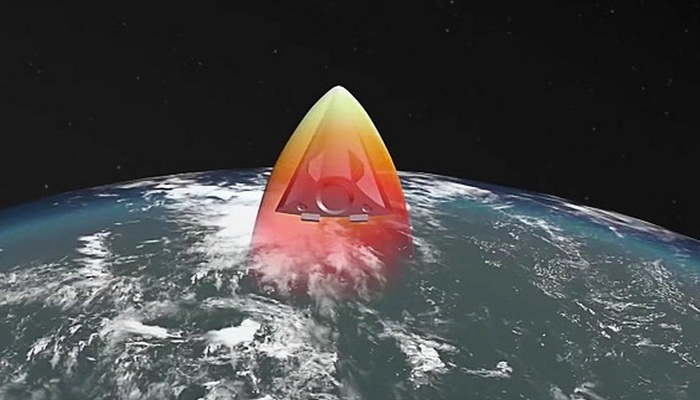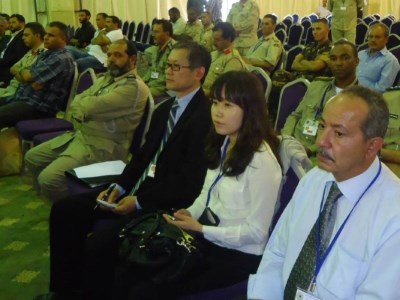"Avangard", meaning in the Russian language, is the vanguard, and in fact it is considered the vanguard of a new type of weapon that appeared recently in the arsenal of Russian strategic missile forces, which is an important component
of Moscow's military strategy. . Many of its exact details are unknown, so the US media describe it as a "nuclear nightmare." The Chinese likened it to the "flying nightmare of the West," describing it as a "masterpiece of the Russian army," describing it as "more powerful than nuclear weapons," as British media described it as an invincible meteor and in fact a mixture of everything that deserves to be called this wonderful weapon. "Weapon of the times."
Overview :
The beginning was in 1985 when it began as a response to the US Strategic Defense Initiative (SDI) bolstering the US anti-ballistic missile defense as well as the widely deployed nuclear warhead attack missiles to enhance American combat capability when the leadership of the Soviet Union was the party's Central Committee disturbed. From that initiative, the Communist Union of the Soviet Union and the Council of Ministers of the Soviet Union issued a resolution demanding that defense companies submit proposals on countermeasures in response to the US SDI program, and this led to the start of the manufacture of a new system with specifications exceeding all that is known in ballistics.
The United States and the USSR in 1972 signed the Strategic Arms Limitation Treaty and at the same time the Anti-Ballistic Missile Treaty, but the first did not adhere to it.
Design and construction:
The Research and Production Association for Machine Building, which is now part of the Tactical Missile Corporation in Russia, took over the project and entrusted the ambitious program to one of the principal engineers, Mr. Gerbert Yefremov, with his team to work on designing the hypersonic hypersonic missile system, and so the journey began. Its design and production, which was more than 30 years ago, during that period the work went through many failures and the team faced many difficulties, especially funding, which led to its suspension. at work. This was around the time of the dissolution of the Soviet Union in 1991, and then the Russian Defense Industries Corporation NPO Mashinostroeniya took over work on the project in the mid-1990s under the name Project 4202, with the participation of several Russian arms manufacturers in the program.
Work continued and reached the testing phase, both on the ground and in flight tests, over a period of time, until it was announced in February 2004 that an ICBM, the UR-100N UTTH, had been launched at the Baikonur test site, carrying a type of faster flying device. The sound is maneuverable in flight. Foreign analysts have reached an assumption about testing a combat unit called 15 U70 believed to be related to the supersonic weapons program.
The world did not know what the flying device was tested with in 2004, but the following events doubted that these tests were within the framework of the "4202" project, but those doubts were quickly dispelled when the Russian media announced in 2010 that they had tested an ICBM with a unit Combat. Brand new, although no news details as usual.
In mid-2011, the Russian Ministry of Defense announced the new weapon system that would be included in the Strategic Missile Forces, and for the first time the name "Avangard" was mentioned, and since then many questions have been raised about new system. ?
In late 2011, a new test of the unit was carried out, and at that time the UR-100NOTTK missile from the Baikonur training field sent a payload to the Kura training field, with a distance of more than 7 thousand kilometers, and the goal was the official launch to verify the new combat equipment capable of overcoming On the missile defense system and in September 2013 another missile was launched with the same targets.
At the end of 2018, the third test of the "Avangard" unit, in which the "SS-19 Steletto" missile, according to the NATO classification equipped with a winged combat unit, was launched from the Dombarovsky district of Orenburg. Governorate (South Central Russia) towards a target located on the Kamchatka Peninsula at a distance About 6 thousand kilometers from the launch site and its hit.
It was later revealed, according to local sources and foreign media, that there were approximately 14 reported test flights for Avangard testing between 1990 and 2018.
Avangard success:
In December 2018, the Russian Ministry of Defense announced the conduct of a final launch test, and with his success the technical characteristics of the new weapon were confirmed, and on the first of March of 2019 President Vladimir Putin officially revealed for the first time information about several promising models of weapons, and among these models was the "Avangard" system. Thus, one of the most daring and most ambitious projects of the past decades has announced its success and appeared under its official name Авангард, the system was put into service and at the same time the contract for the serial production of the Avangard system was signed.
According to the statement of Russian Deputy Prime Minister Yuri Borisov, the speed of the warhead was developed to reach about Mach 27, after which additional practical experiments began, which included a combat system under the direct control of Russian President Vladimir Putin. The success of the new system was completed with the announcement by Russian President Putin on the anniversary of the Russian arms maker to award the medal. Saint Andrew the First Apostle with Swords to Sir Gerbert Yefremov for his development of the Avangard hypersonic missile system.
Supersonic Avangard:
Avangard succeeded in flying at a speed of twenty-seven times the speed of sound for the first time in the world, and it was later revealed that the name Avangard , which differed in the world in what it is, is a hypersonic booster glide vehicle capable of carrying a nuclear weapon under development by the Russian Federation and it is one of six "Next Generation" weapons described by Russian President Vladimir Putin during a speech in March 2018.
There are those who classify it as an advanced, high-speed, intercontinental cruise missile system that carries many advantages and special capabilities in a manner that allows it to carry out offensive missions more effectively and without fear of hostile air defense systems, and these features will make the Avangard a unique means of strategic deterrence or perhaps an unprecedented means of strategic retaliation. .
The Avangard is considered the beginning of a new era of strategic armament systems characterized by super speed, as the unit "Avangard" equipped with a supersonic combat head can fly at 27 times the speed of sound and more than 32,000 thousand kilometers per hour, and it can fly at an altitude of 9 kilometers As well as its superior maneuverability and ability to fly in the dense layers of the atmosphere, changing direction and altitude to prevent hostile means of defense from determining its path and intercepting it, the Avangard carries a nuclear or perhaps conventional payload of 2 metric tons "2000 kg" and according to experts of the Russian Defense Ministry, what is required Less than 50 Interceptors Missiles Avangard.
Avangard's working theory is based on the theory of "boost glide". At the beginning of his journey, the "glide vehicle" moves on a ballistic missile, and after the missile's acceleration, and as soon as the vehicle reaches a sub-orbital peak point with a height of about 100-150 km, the glide vehicle separates from its missile and then flies towards its target certified. On gravity and its aerodynamic properties through the atmosphere at breakneck speeds of more than 20 Mach (6.28 km / s) and can maneuver during flight towards its target and this maneuverability makes Avangard's trajectory unpredictable, complicating attempts to intercept it after the boost phase.
Once the spacecraft reaches the "Carmen Line" where the sub-orbital peak point is about 100-150 km, the glide vehicle detaches from its missile and then sails towards its target through the atmosphere at super-air speeds of Mach 20 (6.28 km / s) and can maneuver. This maneuverability could make the Avangard's path unpredictable, complicating attempts to intercept after the boost phase.
During the testing phase, Avangard was transported on board a ballistic missile carrier, the SS-19 "Stiletto" UR-100NUTTH. It was planned to be transported on the SS-X-31 or RS-26 " missile, but due to financial constraints the carrier was later replaced by the newer missile R -28 "Sarmat".
Avangard is classified as a new weapon that has formed a decisive advantage for Russia in this field, as no country in the world is likely to have such a weapon in the coming years, and it represents a real success in missile technology, as new composite materials have been used to withstand the maximum temperatures reaching 2000 degrees Celsius. Resulting from the unit's high ultrasound speed.
So far there are no real photos available of the Avangard HGV and what has been reported in the media are simulated computer graphics however according to one report it is likely to be a short wedge-shaped, or a shuttle with small stabilizer wings.
Avangard changes attitudes:
Asked by military editor Peter Suciu of The National Interest about "Can Avangard Pose a Serious Threat?" , He answered that the combination of the ability to develop speeds of 27 times the speed of sound and the ability to maneuver and bypass missile defense systems, makes confronting such blocks very difficult, and Socio concluded that "the development of such weapons is unlikely to give America's competitors a great advantage." Because if US ICBMs and strategic bombers are disabled, the United States will still have options available to respond, including actions using nuclear submarines or US Navy ballistic missile boats.
On the other hand, American experts stated that the Avangard missile system will enhance Russia's already strong nuclear capabilities. In the context of this event, the United States needs to think about developing missile defense systems, as it cannot deal with such weapons, as the US defense program has so far focused on interception. Several ballistic missiles launched by a small force, such as North Korea, for example, as a response to retaliation, and these do not possess the technical advantages of the Russian supersonic system, which no one estimated that their speed could reach this limit.
In my estimation, I think that all that this editor mentioned is nothing more than a skepticism about the effectiveness of the Avangard system, as it is impossible to monitor it during its flight or to predict its whereabouts to direct anti-missiles at it and therefore the efforts to counter it are in vain, especially since it is very fast and constantly changes its location and so it does not exist yet For a deterrent weapon capable of confronting a target that may come from any direction in the world, and overcoming it while forgetting that whoever achieves a head start will have a greater chance to destroy his enemy and his success is more complete and forget that the confusion and confusion that will occur as a result of the attack will make the response by other means less effective and this is a great advantage that the Russians achieved in their program The latest in the world.
At the NATO level, the Secretary-General of NATO, Jens Stoltenberg, said at the conclusion of a meeting of the alliance at NATO headquarters in early December 2018 that these missiles are capable of striking European cities within minutes after being launched from Russian territory, and they can also be loaded with nuclear warheads and Russia's goal of establishing this system The new missile is strategically dualistic, as it aims to sow discord between the United States and the Europeans and cause Europeans to divide over how to respond to this system, according to NATO sources.
Therefore, NATO issued a 60-day warning to Russia to adhere to the provisions of the 1987 Treaty on the Limitation of Medium Nuclear Weapons, and issued a statement accusing Russia of violating the treaty by establishing and developing a new missile system and with responsibility for causing great risks to the security of European countries in NATO .
Military experts are unanimous in Russia's monopoly today in the manufacture of "hypersonic glide missiles," and this monopoly is expected to continue until at least the next three years if the United States does not make progress in this regard.
And to this day, all those condemnations and warnings have gone and others will go unheeded, because the language of force that the Russians announced by announcing the entry of the Avangard rotating combat system has actually strengthened the strategic missile force to become the upper hand of the Russian bear, which has become safe from hostile attacks by possessing weapons that no one in the world even possesses right Now.
In a desperate opinion, some American experts believe that the Avangard does not cure anything but the megalomania of Moscow, yet they admit that it is an impressive technical achievement but it solves a problem that does not really exist.
Avangard enters combat shift:
The Avangard system entered combat service practically in December of 2019 within the thirteenth regiment of the Dombarovsky (Red Banner) missile division of the Strategic Missile Forces (Orenburg region), where the first strategic missile regiment was formed armed with hypersonic avangard misile systems and is unknown So far, will the method of its deployment be within fixed underground silos or mobile platforms and thus Russia remains proud of having advanced technologies through which it has developed supersonic ballistic missile systems accurately.
The strategic implications of Avangard:
The Avangard is a weapon of strategic value to possess for two main reasons. One is His maneuverability. and His versatility. It is characterized by superior maneuverability during its flight phase and attack on its target and has the ability to deploy countermeasures during flight allowing it to penetrate air and missile defenses practically undiscovered, making it a difficult target for any missile defense system.
The second is its versatility. Avangard can be equipped with both nuclear and conventional payloads depending on the situation. Moreover, even without an explosive payload, the accuracy and speed of the weapon is believed to have sufficient power to destroy smaller targets, making it an invaluable weapon in the Russian arsenal.
"Hypersonic glide missiles" combine the speed of ballistic missiles and the accuracy of cruise missiles with the ability to maneuver until reaching their target and destroying it without any attempt to confront it and obstruct its path, especially as it reaches the *Carmen Line, which is 100 km from sea level, thus being protected from intercepting defenses American ballistic missiles to shoot down nuclear warheads coming from space, since the Avangard is designed to operate under the umbrella of the ballistic missile shield, that is, under the range of the supposed engagement. This, as mentioned above, gives the Russians the ability to quickly destroy the missiles of the American middle interception system.
Avangard 's strength and technical superiority reinforce its his position as an effective and influential strategic weapon, not only in the balance of military forces, but it goes beyond that to be an effective and effective political pressure for its possession to change the rules of the game in its favor.
Brigadier. Salahadeen Al-Zaidani
Contact the editor: This email address is being protected from spambots. You need JavaScript enabled to view it.
ـــــــــــــــــــــــــــــــــــ
*Carmen line: It is a line located at an altitude of 100 kilometers (62 miles) above the ground from sea level, and is usually used to distinguish between the Earth's atmosphere and outer space. This is the definition approved by the International Aeronautics Union. This line was named after the Hungarian-American physicist and engineer, "Theodore." Von Carmann 1881-1963.
Ballistic missile: A missile that follows a curved or semi-orbital path, a trajectory that is exclusively affected by Earth's gravity, air friction and air resistance.












 English
English  العربية
العربية 








